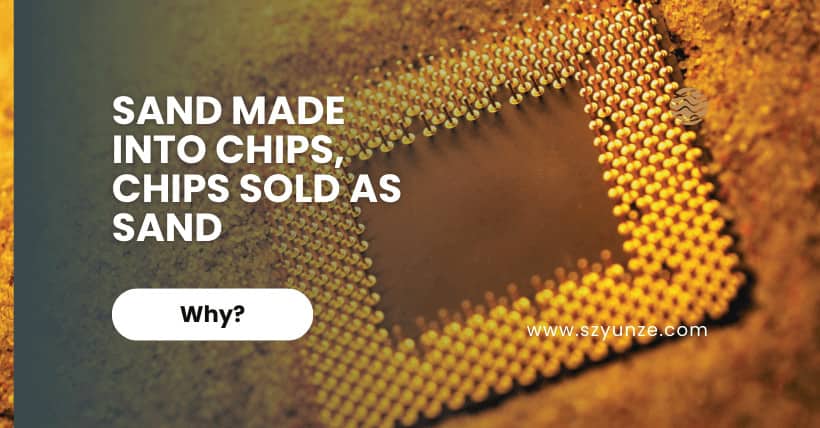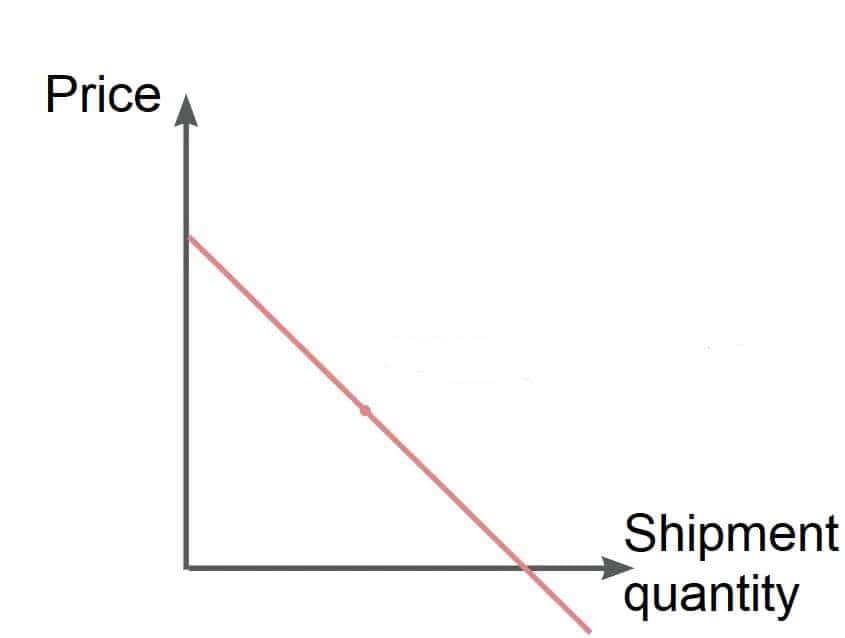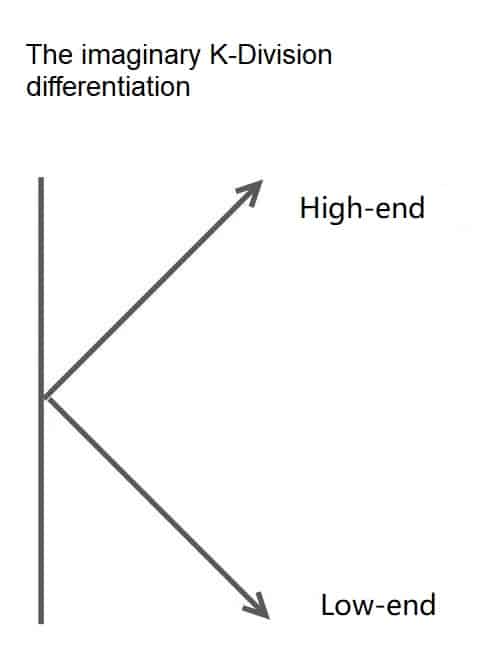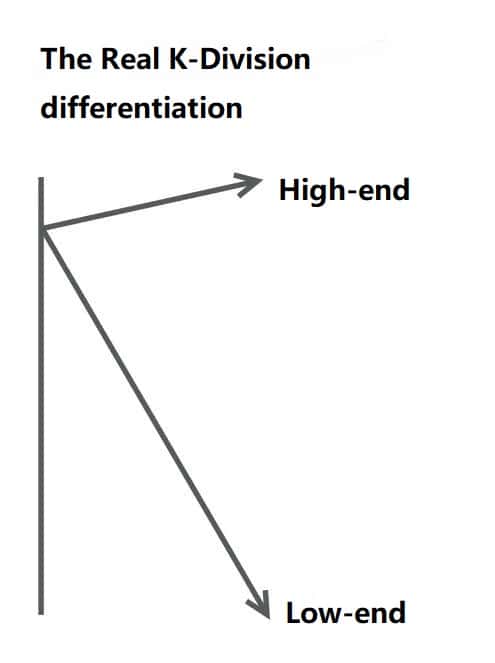
As the first half of the year ends and the second half of the year begins, this is a good time to write a piece on our body of work for the first half of the year [in the consumer IoT industry], which also counts as a retrospective and summary of the first half of 2023.
Sand made into Chips, Chips sold as Sand
This sentence is from two days ago with the shareholders jokingly sent is very appropriate to summarize the situation in the consumer electronics industry, in nothing more than a few words: excess supply, insufficient demand.
Bluetooth chip industry, for example, from the market point of view, we all know that the cheaper the price, the greater the sales volume, drawn a picture is almost like the following.

But the oversupply to a certain extent, rolled up we find the red line can “break” the X-axis, that is, sell at a loss.
Loss of 10-20% of him to sell, inventory clearance or not, back to cash flow or not, to save the stock price or not, the wool began to come out in the pig’s body.
No longer sell, the hand of the chip may become sand.
Our team ran vertically in the first half of the Internet of Things industry chain upstream and downstream of all kinds of enterprises, horizontally run the Internet of Things companies in various industries, nearly 1,000 companies should have, the above story is a microcosm of the industry, the vast majority of companies are not easy.
China’s supply capacity, not to mention so many years to help the United States to lower the CPI, so a big supply to lower China’s CPI capacity is also a “bar”.
Only the pressure is each company’s profits.
Does the country save?
In the first half of the year, there has been a lot of media saying that China’s economic development is not good, the eye of the periphery of many countries to release water, and many countries’ stock index record highs.
Also said that China has entered a deflationary cycle, corporate layoffs, and high unemployment, the economy has entered a negative cycle, and if it does not save the future will be even worse.
Do you want the country to bail out?
If you do, you might want to think about your position.
Some Businesses and Some
Since we are in a highly aggregated service industry chain segment of IoT, we are fortunate to have access to different companies in the same position in the industry chain, to name a few:
A Chip Company
Some chip makers told us that they can cooperate with extremely low gross margins, and the gesture of cooperation is very friendly, but we dare not.
Looking at their not-very-good cost, not-very-good definition of the chip, no good market verification, and only a fight to the death of the gross margin, really worried about their development.
And their similar chips to compete with the original factory told me that they have a 40% gross profit margin, do not know if there is a need to reduce prices, the feeling that price cuts do not start, so there is not much action.
As to their company’s process and stability, most of the similar chip factories are not cost-effective, want to kill the price can be killed competitors doubt life, just whether they have to kill the problem.
They are a healthy money-making enterprise, with long-term planning, more responsible product definition capabilities, and extensive market verification feedback. It may seem that the price is a bit more expensive, but actually, the overall cost of our use will be lower than using other companies’ products.
B Chip Company
Some chip companies have recommended their new high-performance products to me and asked us what industries their high-performance chips can be applied to.
I am a little difficult for them, hundreds of millions of dollars invested in the chip, actually not even thinking about the target market, and the market is seriously out of touch, but also think that the chip is a high-end industry, the definition of the so-called high-end chip (Rising Tide: How Huawei Boosts Mainland Chip Plants), subjective neglect of the huge low-end market, and masturbate to the emergence of the so-called high-end of the new industry.
Another similar chip company told me that their shipments have recently reached a new high.
Why?
The reason is very simple, the supply chain volume, consumer downgrade, profit decline, everyone is looking for a low-cost replacement. Their family’s chip cost is low, the function just meets the market demand, supporting the development of mature, customers will directly switch to their chips, so the order record is high.
Some Factories
We have run through a lot of factories, most of which say they are very bad, very bad, perhaps not encountered in 20 years.
But some factories are “shrinking”, saying that they can’t take over the business, they have good quality control and good supply chain cost, so they don’t worry about the business.
So now take the initiative to choose to do enough volume of products, production capacity to come up, the price can be more competitive, a lot of small amount of projects are rejected.
It is not good to talk about “contraction”, I learned a more advanced word from my friends, which is called “focus”.
In recent years, with more communication with the upstream and downstream, I have a better understanding of such words:
“We don’t do the too low market, we don’t do miscellaneous customers; our main direction now is high-end customers, who have the pursuit of quality and performance; our direction is to do innovative industries, blue ocean market, market segmentation; we don’t do the domestic market, we focus on the overseas market.“
Before I would think they are very pursuing, but now I would wonder if their products are not competitive.
Want the Country to Save?
Different positions, different conclusions.
For example, if Alibaba lays off 30% of its employees, you ask the people who are laid off if they want the country to bail out the market.
Of course, they do!
A friend in Shanghai told me that he knew a friend who was laid off from Alibaba, with an annual salary of one million dollars, one person’s salary to support six people, if the country released water to promote the economy, he may not have to be laid off, and now he is being laid off, how can he do it?
But have we ever thought about those who have not been laid off?
They may not want a state bailout.
There used to be 4 P8s in the department, but now he is the only one left.
For him, after the layoffs, he has less competition, and after tiding over this trough, he will have broader opportunities for development in the future.
Moreover, the layoffs are a recognition of those who were not laid off, because they are better than the others, and it is also a career “victory” at this stage.
This is especially true of corporate competition.
For good companies, the logic is simple:
- a. Although the market has contracted, the demand is there, and will not die;
- b. Their enterprises have enough competitiveness, and must not be washed out;
- c. The bad environment is just enough to wash out the industry’s shit-stirrers and death-defying lunatics and return the industry to a healthy atmosphere.
Just like the school bully will is afraid that the college entrance examination paper is too difficult?
No, what they are afraid of is that the paper is too simple and they can’t close the gap with the fish.
What does a Great Business look like?
Two years ago I heard a term from a class on websites, K-Division.
That is, the market will gradually polarize into high-end and low-end markets.
The high-end market values brand, quality, and emotional value.
The low-end market values cost-effectiveness.
Draw a diagram like this:

But when I talk to KA brand customers and miscellaneous factories in the same industry I find that the reality is a bit twisted and the actual K-division should look like this.

When I talk to some industry brand customers, I discuss and analyze with them:
The market is immature in the early stage, miscellaneous manufacturers will give priority to trying new markets and seize the first opportunity, Now that the market is mature, there are big brands down the field, that can be harvested on miscellaneous brands, low-risk to take the business.
But they don’t agree. The reasons are:
a. In the smart product category, the big brands I recognize are far less recognized than the miscellaneous brands I recognize, and conversely, the miscellaneous brands I recognize are the head brands inside this smart category, while the traditional big brands I recognize are not well-known in this smart category.
Just as the Internet said, new energy vehicles, BBA are miscellaneous brands, Tesla, BYD, and Wei Xiao Li are the mainstream.
b. They can’t make the so-called miscellaneous brand companies cost-effective, because the gross profit required by their brand companies, the control of the progress of product development, and the research of the response to the new features is also slow, and can’t meet the requirements of the rapid development of the Internet of Things now. This is the reason why they look for us to cooperate with them, hoping that we can provide fast and cost-effective product solutions.
I think there are several reasons for this K-shaped divergence situation now:
- a. China’s supply-side exuberance, no technical threshold and rapid iteration of the market game, rapid convergence of product features;
- b. Technology and processes are becoming more mature, reducing quality problems and brand quality benefits;
- c. Sales channels are becoming more and more developed, and the information gap is gradually smoothed out, resulting in the disappearance of the information gap premium;
- d. Consumer wealth shrinkage, consumption downgrading.
These are also the reasons why Pinduoduo beat Tmall, right?
Going back to the previous question, what does a great business look like?
Is the product good value for money?
No, far from it.
At least in industries with no absolute barriers, I think an excellent company is excellent in all aspects, with a very high overall score. Including but not limited to product performance, product selling price, company team, corporate management, supply chain costs, marketing capabilities, decision-making strategy, and so on.
Just like the school bully can not only be one subject bully but must be excellent in all aspects.
Brutal and Yet more Simple
A few days ago, I had dinner with a friend in Shenzhen, and my friend said that entrepreneurship is not something that people do.
It’s hard, just as hard as getting into Tsinghua University.
But the market is very big, in the contraction is also in the differentiation, for most small and medium-sized companies, small wind stand right, as usual growth and development.
Now let the market also help “layoffs”, so that the next cycle will be better development.
This year, it seems that with the development of many companies’ less fancy things, we have returned to the essence of business – and made into chips, chips sold into the sand!
I also see a lot of previous financing to tell the story of the company, now also from the virtual to the real, began to sell the program to do business.
On the contrary, when I do not do business with some companies, always have questions, friends who know these companies are saying this: it’s not working, the boss is ready to cash, and all kinds of run PR is to investors.
Words in the end
A while ago with a few friends in the Internet of Things circle dinner, we lamented that we just graduated into the industry or a group of rookies, and now 10 years later, we boiled into the circle of “senior people”.
Over the past 10 years, we have watched the rise and fall of various “products of the times”, and repeatedly witnessed our friend’s remark that “there are fewer and fewer friends in the circle”.
We are glad that we have not been washed out of this industry, and hope to have the opportunity to accompany the Internet of Things industry has been developing.

Recommended Reading:


